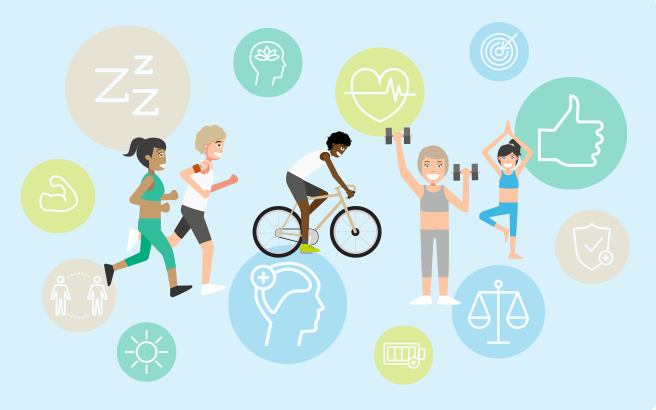 Matt Lambert, a WCRF nutritionist who worked for 10 years as a fitness trainer, takes a look at the UK’s updated physical activity guidelines. He explains what they mean and how we can build them into our everyday lives.
Matt Lambert, a WCRF nutritionist who worked for 10 years as a fitness trainer, takes a look at the UK’s updated physical activity guidelines. He explains what they mean and how we can build them into our everyday lives.
Having spent 10 years working as a fitness trainer, I have seen first-hand the benefits that physical activity can have on our health – both physically and mentally.
Health benefits
When we think of the physical benefits of keeping active, we typically think of the benefits it brings to our fitness and how we look, such as losing weight and increasing muscle tone. It does, however, provide much greater benefits, such as reducing our risk of cancer, heart disease and type 2 diabetes. There are also the sometimes-overlooked mental wellbeing benefits, such as enhancing self-esteem, improving mood, reducing anxiety, and increasing our resilience to stress. Some experts have gone as far as to say that if we could put the benefits of physical activity into a pill it could be the most potent medicine one could take!
How much physical activity should we do?
Physical activity is essentially anything that gets us moving – from taking the stairs to just moving around, to walking, to structured exercise such as doing an exercise class. But how much do we need to benefit our health?
The UK physical activity guidelines were recently updated, and advise the following:
- Each week, adults should accumulate at least 150 minutes (two and a half hours) of moderate-intensity activity such as brisk walking or cycling
- or 75 minutes of vigorous-intensity activity such as running
- or even shorter durations of very vigorous-intensity activity such as sprinting or stair climbing
- or a combination of moderate, vigorous and very vigorous-intensity activity
While some of us may be familiar with the guideline amount of 150 minutes of moderate-intensity activity each week, the new guidelines showed that this can be accumulated in bouts of any length. The fact that the health benefits can be achieved from doing small but regular chunks of activity throughout the day means that it doesn’t need to be so daunting to achieve the recommended amounts of physical activity each week.
Different types of physical activity
An underappreciated recommendation is to also perform strength exercises on at least two days a week. Given the importance of maintaining or increasing muscle strength, this is one of the areas that has been given greater prominence in the new guidelines. Being strong makes all movement easier and increases our ability to perform normal daily tasks. In addition, when we get older, we start to lose muscle and therefore strength. However, doing heavy gardening, carrying heavy shopping, or resistance exercise can help to maintain strength, which makes everyday tasks such as getting in and out of the chair easier, and helps to reduce the risk of falls.
The guidelines also highlighted the risks of inactivity and sedentary behaviour to our health. To combat this, we should try to minimise the amount of time spent being sedentary and break up long periods of inactivity with light physical activity. For example, if you’re at work, instead of emailing a colleague, get up and walk over to them. Fitness trackers are useful for reminding you to get off your chair or sofa every hour – it’s these little changes that add up over time.
If it’s been a while since you were regularly active, it’s important to start gradually and slowly build up how much you do. All that matters, in the beginning, is that you do what you are capable of. Find an activity you enjoy, whether that’s playing with the kids or grandkids, going for a walk, gardening or cycling – doing something that you enjoy means you’re more likely to stick to it.
National Fitness Day
Keep an eye out for National Fitness Day this Wednesday, 25 September – encouraging the nation to celebrate the fun of fitness and physical activity across the UK and highlighting the role physical activity plays in helping us lead healthier and active lifestyles.

